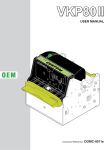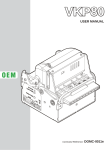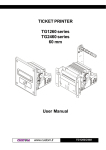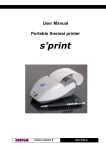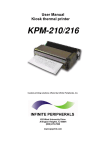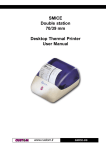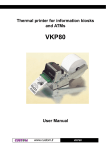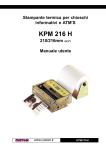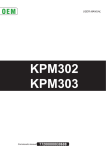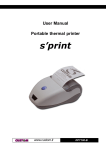Download Custom Engeneering PLUS II User manual
Transcript
Ultra-Small Thermal Panel Printer Mini PLUS User Manual www.custom.it Mini PLUS All rights reserved. Total or partial reproduction of this manual in whatever form, whether by printed or electronic means, is forbidden. While guaranteeing that the information contained in it has been carefully checked, CUSTOM ENGINEERING SPA and other entities utilized in the realization of this manual bear no responsibility for how the manual is used. Information regarding any errors found in it or suggestions on how it could be improved are appreciated. Since products are subject to continuous check and improvement, CUSTOM ENGINEERING SPA reserves the right to make changes in information contained in this manual without prior notification. COD. DOME-MINIPLUS Copyright © 2004 CUSTOM ENGINEERING SPA – Italy CUSTOM ENGINEERING SPA Str. Berettine 2 - 43010 Fontevivo (PARMA) - Italy Tel.: +39 0521-680111 Fax: +39 0521-610701 http: www.custom.it Customer Service Department: Tel.: +39 059 88 69 587 Email : [email protected] Mini PLUS REV. 1.10 PRINTER COMPONENTS A. Front external view 1- Paper outfeed 2- Frontal Panel 3- Cover opening levers 1 2 3 Mini PLUS B. Rear external view 1- Power supply connector 2- RS232 serial interface connector and other signals. 2 Mini PLUS 1 TABLE OF CONTENTS INTRODUCTION MANUAL CONTENTS ...................................................................................................................................... EXPLANATORY NOTES USED IN THIS MANUAL ........................................................................................... GENERAL SAFETY INFORMATION ................................................................................................................ UNPACKING THE PRINTER ............................................................................................................................ GENERAL FEATURES .................................................................................................................................... PRINTER DESCRIPTION ................................................................................................................................. 1 1 1 2 2 3 1. INSTALLATION AND USE 1.1 CONNECTIONS ...................................................................................................................................... 1.1.1 Power Supply .................................................................................................................................. 1.2 SELF-TEST ............................................................................................................................................. 1.3 CONFIGURATION ................................................................................................................................... 1.4 HEXADECIMAL DUMP ............................................................................................................................ 1.5 MAINTENANCE ...................................................................................................................................... 1.5.1 Changing the paper roll .................................................................................................................... 1.5.2 “EASYLOCK” fixing system ............................................................................................................ 1-1 1-1 1-2 1-2 1-3 1-3 1-3 1-5 2. INTERFACES 2.1 RS232 SERIAL ....................................................................................................................................... 2-1 3. PRINTER FUNCTIONS 3.1 PRINT DIRECTION .................................................................................................................................. 3-1 3.2 CONTROL CHARACTERS ...................................................................................................................... 3-1 4. TECHNICAL SPECIFICATIONS 4.1 TECHNICAL SPECIFICATIONS ............................................................................................................... 4-1 4.2 DIMENSIONS .......................................................................................................................................... 4-3 5. CHARACTER SETS 5.1 CHARACTER SETS ................................................................................................................................ 5-1 APPENDIX A - ACCESSORIES AND SPARE PARTS A.1 ACCESSORIES ...................................................................................................................................... A-1 A.1.1 Power supply .................................................................................................................................. A-1 A.1.2 Data and power suplly cable kit ...................................................................................................... A-3 A.2 SPARE PARTS ....................................................................................................................................... A-4 i Mini PLUS INTRODUCTION MANUAL CONTENTS In addition to the introduction which includes a description of the explanatory notes used in the manual, general safety information, how to unpack the printer and a brief description of the printer including its basic features, this manual is organized as follows: Chapter 1: Contains the information required for correct printer installation and its proper use Chapter 2: Contains information on interface specifications Chapter 3: Contains a description of the printer command set Chapter 4: Contains Technical Specifications of the printer Chapter 5: Contains the character sets (fonts) used by the printer EXPLANATORY NOTES USED IN THIS MANUAL N.B. Gives important information or suggestions relative to the use of the printer. WARNING Information marked with this symbol must be carefully followed to guard against damaging the printer. DANGER Information marked with this symbol must be carefully followed to guard against operator injury or damage. GENERAL SAFETY INFORMATION • • • • • • • • • • • • • • Read and keep the instructions which follow. Follow all warnings and instructions indicated on the printer. Before cleaning the printer, disconnect the power supply cable. Clean the printer with a damp cloth. Do not use liquid or spray products. Do not operate the printer near water. Pay attention that the external frame, the cover and the printer frame are made from polypropylene, so it’s better to keep away from: √ ammonia √ methanol √ acetone √ washing-up liquid √ benzol √ dishwasher liquid √ hydrocarbon √ dichloromethane √ perchloretylene √ ethylene √ trichlorethylene √ toluene Do not use the printer on unstable surfaces that might cause it to fall and be seriously damaged. Use the type of electrical power supply indicated on the printer label. If in doubt, contact your retailer. Make sure the printer is placed in such a way as to avoid damage to its wiring. Make sure that the maximum load absorbed by the printer does not exceed the approved Maximum load by the type of cable used to supply. Do not introduce foreign objects of any kind into the printer as this could cause a short circuit or damage parts that could jeopardize printer functioning. Do not spill liquids onto the printer. Do not carry out technical operations on the printer, with the exception of the scheduled maintenance procedures specifically indicated in the user manual. Disconnect the printer from the electricity supply and have it repaired by a specialized technician when: A. The feed connector has been damaged. B. Liquid has seeped inside the printer. C. The printer has been exposed to rain or water. 1 Mini PLUS INTRODUCTION D. The printer is not functioning normally despite the fact that all instructions in the users manual have been followed. E. The printer has been dropped and its outer casing damaged. F. Printer performance is poor. G. The printer is not functioning. UNPACKING THE PRINTER Remove the printer from its carton being careful not to damage the packing material so that it may be re-used if the printer is to be transported in the future. Make sure that all the components illustrated below are present and that there are no signs of damage. If there are, contact Customer Service. 1. 2. 3. Printer Paper roll (inside the printer) Manual (or Instructions Sheet) (Fig.1) 1 2 3 GENERAL FEATURES Ultra small and ultra-compact thermal panel printer, with light weight. 58mm paper width, 30mm paper roll diameter with easy paper loading system. Mini PLUS is provided with the innovative fixing system “EASYLOCK”: this system allows to fit the printer to any panel thickness. Mini PLUS is suitable for portable systems, diagnosis/ analysis and control systems, EFT/ POS, industrial instruments, etc. Mini PLUS is supplied by 5 Vdc and is available with serial RS232 (optional TTL serial interface) and paper sensor. Mini PLUS 2 INTRODUCTION it’s equipped with a 203 dpi thermal printing mechanism, using 57,5 mm-wide paper rolls. It can print 24 or 40 characters per line according to the selection made at the setup stage or through a software command; label printing is not possible. PRINTER DESCRIPTION The printer has an ABS casing (ref.1 of fig. 2) with a front cover (ref. 2 of fig. 2) which opens to allow access to the paper roll and print head. (Fig.2) 1 2 • External FEED key (connect to serial connector see the paragraph 2.1). When the FEED key is pressed, the printer advances the paper. During power-up, if the FEED key is held down, the printer enters the SETUP routine. • The external STATUS led (connect to serial connector see the paragraph 2.1) displays printer operating status and this check is performed “on-line”. Table 1 lists operating statuses and the LED signals connected to them: (Tab. 1) LED status Description Always off Printer off Always on Printer on - no fault Slow blinking Paper Out message Fast blinking Recoverable error (head overtemperature, supply voltage error) 3 Mini PLUS INTRODUCTION Blank page Mini PLUS 4 1. INSTALLATION AND USE 1.1 CONNECTIONS Pin 1 (Fig.1.1) 1.1.1 Power Supply The printer is equipped with a 4 pin JST male connector (SMT) for the power supply. The signals on the connector pins are as follows:: Model no. type: Pin no. Header : Housing : B4B-PH-SM3-TB (JST) PHR-4 (JST) or equivalent Signal (Tab.1.1) Notes 1 GND 2 GND 3 +VP: 5 Vdc ± 10% (head voltage) 4 +VC: 5 Vdc ± 5% (logic supply voltage) WARNING Respect the polarity of the power supply. 1- 1 Mini PLUS 1. INSTALLATION AND USE 1.2 SELF-TEST Printer operating status is indicated in the configuration print-out in which, next to the name of the components displayed (see figure 1.2), the following information is given: • under HEAD TEMPERATURE is given the temperature of the head. • under HEAD VOLTAGE is given the voltage of the head. * PRINTER SETUP * (Fig.1.2) HEAD TEMPERATURE [°C]= 32.5 HEAD VOLTAGE [V] = 5,0 Baud Rate Data length Parity Handshaking Autofeed Columns Print Mode Chars Mode Print Density [PUSH] [FAST PUSH] : 38400 bps : 8 bits/chr : None : Xon/Xoff : CR disabled : 24 col. : Normal : Normal :0 ENTER SET-UP EXIT 1.3 CONFIGURATION This printer permits the configuration of default parameters. The printer’s configurable parameters are: • Baud Rate: 38400, 19200D, 9600, 4800, 2400,1200, 600. • Data length: 7, 8D bits/car. • Parity: NoneD, Even or Odd. • Handshaking: XON/XOFFD or Hardware. • Autofeed: CR disabledD or CR enabled. • Columns: 24 col.D , 40 col. • Print Mode: NormalD or Reverse. • Char Mode: NormalD , Double width (2 x Width), Double height (2 x Height), Expanded. • Print density: -2, -1, 0D, +1, +2. Please note: the parameters marked with the symbol D represent the default values. The settings made are stored in nonvolatile memory and are loaded automatically . During power-up, if the FEED key (1) is held down, the printer enters the autotest routine and prints out the setup report. The printer will remain in standby in Hexadecimal dump mode (see section 1.4) until another key is pressed or characters are received through the printer communication port. When the FEED key (1) is pressed, the printer enters parameter configuration. Each time the FEED key (1) is pressed, the parameter will change and the current value will be printed out. Once the desired value has been attained, hold the FEED key (1) down for at least a second to pass to the next parameter, and so on. Printing out of a new printer set up report indicates that set up is complete. NOTE(1): The FEED key is external and must be connected to serial connector as indicated in paragraph 2.1. Mini PLUS 1- 2 1. INSTALLATION AND USE 1.4 HEXADECIMAL DUMP This function is used to display the characters received from the communications port; after the reception of each 8 characters from the communications port, the printer prints out both the hexadecimal code received as well as the corresponding ASCII code. Shown below is an example of a Hexadecimal Dump: 48 6D 20 6E 36 65 6D 75 65 61 66 20 37 66 6E 76 78 6C 75 30 38 67 6F 77 61 20 6E 31 39 68 70 78 64 64 63 32 61 69 71 79 65 75 74 33 62 6A 72 7A 63 6D 69 34 63 6B 73 69 70 6F 35 64 6C 74 Hexadeci mal dump functio n 012345 6789abcd efghijkl mnopqrst uvwxyz 1.5 MAINTENANCE 1.5.1 Changing the paper roll To change the roll of paper, proceed as follows: 1) Open the printer cover as shown in fig. 1.3; (Fig.1.3) 1- 3 Mini PLUS 1. INSTALLATION AND USE 2) Position the paper roll making sure it unrolls in the proper direction as shown in the figure 1.4; (Fig.1.4) 3) Tear off the paper as shown in fig. 1.5 and re-close the cover; (Fig.1.5) Mini PLUS 1- 4 1. INSTALLATION AND USE 4) The printer is ready. (Fig.1.6) 1.5.2 “EASYLOCK” fixing system This system allows to adapt the printer to every panel thickness and it is not necessary to use other fixing tools. To fix the printer you can use only the 2 hooks, already mounted on the printer, stopping the printer in the more convenient position. To remove the fixing hook, referring picture 1.7: -using a flat screwdriver lift the flap (1) and at the same time take away (2) the hook. (Fig.1.7) 1 1- 5 2 Mini PLUS 1. INSTALLATION AND USE Blank page Mini PLUS 1- 6 2. INTERFACES 2.1 RS232 SERIAL Pin 1 (Fig.2.1) The printer with a serial RS232 has a molex 6-pin male connector 53398 series (Vertical SMT). Refer to the table below for the connector pin signals: Model no. type : Header : Housing : Molex 53398 series 6-pin (no. 53398-0690) Molex 51021 series 6-pin (no. 51021-0600) (Tab.1.1) Pin no. Signal IN/OUT Description 1 DTR OUT Data Terminal Ready 2 TX OUT Data transmission 3 RX IN Data reception 4 GND - Signal ground 5 FE E D IN FEED signal (active at low level) 6 LE D OUT LED signal (active at high level) 2- 1 Mini PLUS 2. INTERFACES The following scheme, shown in figure 2.2, represent the connection cable configuration between Molex connector 51021 series 6-pin (female) and a 9-pin connector (female). This cable can be use as wiring between the printer board and a 9-pin connector (male) of a generic host. (Fig.2.2) 1 2 3 4 5 6 DTR TX RX GND FEED LED DCD RX TX N.C. N.C. N.C. 1 2 3 4 5 6 7 8 9 HOST PRINTER Mini PLUS 2- 2 3. PRINTER FUNCTIONS 3.1 PRINT DIRECTION The printer has two printing directions which can be selected by means of the control characters: normal and reverse. Small panel printer Normal mode Small panel printer PLUS PAPER OUTFEED DIRECTION PLUS Reverse mode (Fig.3.1) 3.2 CONTROL CHARACTERS LEGEND : Symbol $ {} n, m, t, x, y Function indicates the representation of the command hexadecimal value (for example $40 means HEX 40). indicates an ASCII character not performable. are additionals/optional parameters that can have different values. The command table lists all the commands for the management of the printer functions. The commands can be transmitted to the printer at any moment, but they will only be carried out when the characters previously transmitted have been printed or the commands previously transmitted have been carried out. There are no commands with priority status; all the commands are carried out when the circular buffer is free to do so. HEX $00 $01 $02 $03 $04 $0A (n) $0B ASCII COMMAND TABLE Description (Table 3.1) Note Prints in small characters Prints in double width Prints in double height Expanded printing Restores small character printing Forward feeds one line Forward feeds (n) line 3-1 Mini PLUS 3. PRINTER FUNCTIONS H EX ASCII $0D $0F $11 $1B $23 n $1B $40 $1B $41 $1B $49 (dd) $1B $4D $1B $4E $1B $51 $1B $52 $1B $57 $1B $61 $1B $63 $1B $68 $1B $69 $1B $6D $1B $71 $1B $73 $1B $76 $1B $FA n1 n2 $1D $24 n $1D $49 n $1D $55 $1D $57 n ESC # n ESC @ ESC A ESC I (dd) ESC M ESC N ESC Q ESC R ESC W (dd) ESC a ESC c ESC h ESC i ESC m ESC q ESC s ESC v ESC { } n1 n2 GS $ n GS I n GS U GS W n Description Note Prints line buffer Sets CRLF mode Graphic mode Transmit printer ID Resets the printer Executes [n] dots line feed Selects 24 columns Writes value (dd) in print mode Sets normal mode printing Enables underlining Sets reverse mode printing Prints graphic line of 200 dpi Selects number of dot spaces Management of bar code printing Selects 42 columns Selects 40 columns Transmits print mode in serial Disables underlining Transmits next character in serial Transmits printer ID Prints graphic Set absolute shift into a graphic line Transmits the printer ID Resets printer parameters to default value Prints n byte of a 200 dpi graphic line The following pages provide a more detailed description of each command. $00 [Name] [Format] [Description] [Notes] [Default] [Reference] [Example] Small character printing ASCII {} Hex 00 Decimal 0 The printer prints in small characters (normal) • The commands $00 - $09 do not cancel the print buffer • The commands which modify the direction of the characters are only active at the beginning of the line Setting in option register by means of front keys $01, $02, $03, $04 $01 [Name] [Format] [Description] Double width printing ASCII {} Hex 01 Decimal 1 The printer prints in double width format Mini PLUS 3-2 3. PRINTER FUNCTIONS [Notes] [Default] [Reference] [Example] • The commands $00 - $09 do not cancel the print buffer • The commands which modify the direction of the characters are only active at the beginning of the line Setting in option register by means of front keys $00, $02, $03, $04 $02 [Name] [Format] [Description] [Notes] [Default] [Reference] [Example] Double height printing ASCII {} Hex 02 Decimal 2 The printer prints in double height format • The commands $00 - $09 do not cancel the print buffer • The commands which modify the direction of the characters are only active at the beginning of the line Setting in option register by means of front keys $00, $01, $03, $04 $03 [Name] [Format] [Description] [Notes] [Default] [Reference] [Example] Expanded printing ASCII {} Hex 03 Decimal 3 The printer prints in expanded character mode • commands $00-$09 do not cancel the print buffer • the commands which modify the dimensions of the characters are only active at the beginning of the line Setting in the option register by means of the front keys $00, $01, $02, $04 $04 [Name] [Format] [Description] [Notes] [Default] [Reference] [Example] Restore small character printing ASCII {} Hex 04 Decimal 4 The printer resumes printing with small characters • The commands $00-$09 do not cancel the print buffer • the commands which modify the dimensions of the characters are only active at the beginning of the line Setting in the option register by means of the front keys $00, $01, $02, $03 3-3 Mini PLUS 3. PRINTER FUNCTIONS $0A [Name] [Format] [Description] [Notes] [Default] [Reference] [Example] Forward feeds one line ASCII {} Hex 0A Decimal 10 Forward feeds one line equivalent to a line of print • This command brings about the printing of the contents of the line buffer • If the line buffer is empty this command executes a line feed of 24 dots (= 3 mm). If the line buffer contains text the line feed is = (character height + spacing) dots ( default = 4 mm). $0B (n) $0B [Name] [Format] [Description] [Notes] [Default] [Reference] [Example] Forward feeds (n) lines ASCII {} Hex 0B Decimal 11 Carries out the number of line feeds specified in (n) •The number must be ASCII and between 0 and 9 (when n=0 the command is ignored) • This command clears the line buffer $0A To forward feed fast, 5 lines at a time: $35 $0B (or 5 and the command $0B) $0D [Name] [Format] [Description] [Notes] [Default] [Reference] [Example] Print the line buffer ASCII {} Hex 0D Decimal 13 This command prints the line buffer • If the line buffer is empty, the command is ignored • If the CRLF option is set, this command is ignored and printing can only be ordered through the command $0A $0F $0F [Name] [Format] [Description] Set CRLF mode ASCII {} Hex 0F Decimal 15 Inhibits the command $0D maintaining enabled only the command $0A for printing Mini PLUS 3-4 3. PRINTER FUNCTIONS [Notes] [Default] [Reference] [Example] • To disable this option, reset the printer • This command clears the line buffer • On switching on the default value is in the Option Register Setting in the option register by means of the front keys $0D $11 [Name] [Format] [Description] [Notes] [Default] [Reference] [Example] Graphic mode ASCII {} Hex 11 Decimal 17 Enables graphic mode: a line in 24 column mode corresponds to 144 horizontal dots divided into 24 blocks of 6 dots each; a line in 40 column mode corresponds to 240 horizontal dots divided into 40 blocks of 6 dots each. To obtain graphic printing, enter the command $11 at the beginning of each line. The format of the byte in graphic configuration is: X R P6 P5 P4 P3 P2 P1 D7 D6 D5 D4 D3 D2 D1 D0 where: X is not used (0 is recommended); R must be fixed at level 1; P1,.P6 are the graphic dot data (1 prints, 0 does not print). The P6 bit of the string of dots transmitted is printed on the left and the others follow from left to right (P5, P4, P3, P2, P1) as shown: 1st byte Î 2nd byte Î 3rd byte Î P6 P5 P4 P3 P2 P1 P6 P5 P4 P3 P2 P1 P6 P5 P4 P3 P2 P1 To print a line of dots, transmit: $11, n x $7F (where n is the number of characters per line), $0D. To print an empty line, transmit: $11, $40, $0D. $1B $23 n [Name] [Format] [Range] [Description] Transmit printer ID ASCII ESC # n Hex 1B 23 n Decimal 27 73 n 1 ≤ n ≤ 3, 49 ≤ n ≤ 51 Transmits the printer ID specified by n follows: n Printer ID Specification 1, 49 Printer model ID $1B 2, 50 Not used Fixed on $00 3, 51 ROM version ID Depends on version ROM (4 char) 3-5 Mini PLUS 3. PRINTER FUNCTIONS [Notes] • This command is executed when the data is processed in the data buffer. Therefore, there could be a time lag between command reception and data transmission, depending on data buffer status. [Default] [Reference] [Example] $1B $40 [Name] [Format] Resets the printer ASCII ESC @ Hex 1B 40 Decimal 27 64 Cancels all the data in the print buffer and resets the printer mode, restoring the mode which was enabled at the moment of switching on • Same as hardware reset • After the command has been transmitted, 1.5 seconds elapse before the printer is enabled [Description] [Notes] [Default] [Reference] [Example] $1B $41 n H n L [Name] [Format] [Description] [Notes] [Default] [Reference] [Example] Executes [n] dots line feed ASCII ESC A nH nL Hex 1B 41 nH nL Decimal 27 65 nH nL Executes [n] dots line feed where N = 256 x nH + nL. • 1 mm = 8 dot line. • The maximum paper line feed value is about 1 m. To forward feed 40mm send this sequence : $1B $41 $01 $40 (the ESC A command with 40mm x 8dot) $1B $49 [Name] [Format] [Description] [Notes] [Default] [Reference] [Example] Selects 24 columns ASCII ESC I Hex 1B 49 Decimal 27 73 On receiving this command, the printer enters 42-column per line printing mode. $1B $69, $1B $68 Mini PLUS 3-6 3. PRINTER FUNCTIONS (dd) $1B $4D [Name] [Format] [Range] [Description] [Notes] [Default] [Reference] [Example] Writes the value (dd) in the print mode ASCII dH dL ESC Hex dH dL 1B Decimal dH dL 27 dH = 48 48 ≤ dL ≤ 51 Sets the print mode default parameters: $00 small character printing $01 double width printing $02 double height printing $03 expanded printing • The setting is stored in the EEPROM Setting by means of the front keys $1B $6D For double height printing, transmit: $30 $32 $1B $4D M 4D 77 $1B $4E [Name] [Format] [Description] [Notes] [Default] [Reference] [Example] Set normal mode printing ASCII ESC N Hex 1B 4E Decimal 27 78 Select normal mode printing:the receipt feeds out of the printer with the printing upside down running from right to left Setting in option register by means of front keys $1B $52 $1B $51 [Name] [Format] [Description] [Note] [Default] [Reference] [Example] Enable underlined printing ASCII ESC Q Hex 1B 51 Decimal 27 81 After this command has been received, the characters are printed underlined. $1B $71 $1B $52 [Name] [Format] Set reverse mode printing ASCII ESC R Hex 1B 52 Decimal 27 82 3-7 Mini PLUS 3. PRINTER FUNCTIONS [Description] Selects printing in reverse mode: the receipt feeds out of hte printer with the printing in normal mode running from left to right. [Notes] [Default] [Reference] [Example] Setting in option register by means of front keys $1B $4E $1B $57 [Name] [Format] Prints a graphic line at 203 dpi ASCII ESC W Hex 1B 57 Decimal 27 87 After receiving this command, the printer waits for 48 bytes which correspond to an entire graphic line. In fact, 48 bytes of 8 bits each correspond to 384 dots per line. [Description] [Notes] [Default] [Reference] [Example] (dd) $1B $61 [Name] [Format] [Description] [Notes] [Default] [Reference] [Example] Selects the number of dot spaces ASCII (dd) ESC a Hex (dd) 1B 61 Decimal (dd) 27 97 By using (dd) parameters it’s possible to select the dot line number between one print line and another. • (dd) are two ASCII characters (selected between ‘0’, ‘1’, ..., ‘9’, ‘A’, ‘B’,..., ‘F’) which identifies number from 0 to 127 in hexadecimal form and corresponds to the number of dot lines between one print line and another. The acceptable range is from 00H to 7FH. 0 $1B $63 [Name] [Format] [Description] Management of bar code printing ASCII ESC c [code] [height] [position] [options] [length] [data] Hex 1B 63 Decimal 27 99 [ASCII code] Type of bar code I Interleaved 2/5 C Code 39 B CodaBar e EAN8 E EAN13 [height] Number of dot lines in 1/8 mm. units. Mini PLUS 3-8 3. PRINTER FUNCTIONS [position] Left hand margin, expressed in 1/8 mm. units [options] Specify the bar code options trough a byte. In the following tables are listed alls the possibles values of single bit inside of byte : Bi t 0 0 1 Function Check digit is not printed Check digit is printed Bi t 1 Bi t 3 0 0 Bi t 2 0 1 Function No Above 1 1 0 1 Below Above & below Bi t 5 0 0 Bi t 4 0 1 Function Normal Double 1 1 0 1 Triple Not used Bi t 6 7 [Notes] [Default] [Reference] [Example] Function Not used Function Not used Not used Description Check digit Description Description HRI position Description Barcode width Description - [length] Specify the characters number to print trough a byte; in following are listed the maximum lenghts allowed : Interleaved 2/5 = 12 characters Code 39 = 10 characters CodaBar = 10 characters EAN8 = 7 characters EAN13 = 12 characters [data] Specify the characters to print expressed in ASCII • For EAN8 and EAN13 barcodes the check digit is automatic. • When CODE 39 barcode is used with triple width function, if 6 characters + check digit are sent the print limits are exceeded, so the barcode can’t be printed. In the following example is indicated the command sequence to print a barcode : $1B, ‘N’, $1B, ‘c’, ‘C’, $50, $3C, $14, $04, ‘PLUS’ 3-9 Mini PLUS 3. PRINTER FUNCTIONS where : $1B, ‘N’ $1B, ‘c’, ‘C’, $50, $3C, $14, $04, ‘PLUS’ (sets the printing in normal mode ) (bar code printing command) (barcode type = Code 39) (barcode heigth = 10 mm) (starting position = 7,5 mm) (HRI printing below, barcode width double) (characters number to print) (characters to print) [Notes] [Default] [Reference] [Example] $1B $68 [Name] [Format] [Description] [Notes] [Default] [Reference] [Example] Selects 42 columns ASCII ESC h Hex 1B 68 Decimal 27 104 On receiving this command, the printer enters 42-column per line printing mode. $1B $49, $1B $69 $1B $69 [Name] [Format] [Description] [Notes] [Default] [Reference] [Example] Selects 40 columns ASCII ESC i Hex 1B 69 Decimal 27 105 On receiving this command, the printer enters 40-column per line printing mode. $1B $49, $1B $68 $1B $6D [Name] [Format] [Description] [Notes] [Default] [Reference] [Example] Transmits the print mode in serial ASCII ESC m Hex 1B 6D Decimal 27 109 Transmits the print mode configuration on the serial port • If the printer is using the parallel protocol, nothing with be transmitted Setting in the option register by means of the front keys The response is on two bytes. E.g. if you receive: Mini PLUS 3-10 3. PRINTER FUNCTIONS $30, $32 it means that printing is in double height mode $1B $71 [Name] [Format] [Description] [Notes] [Default] [Reference] [Example] Disables underlined printing ASCII ESC q Hex 1B 71 Decimal 27 113 Annuls underlined printing $1B $51 $1B $73 [Name] [Format] [Description] [Notes] [Default] [Reference] [Example] Transmits the next character in serial ASCII ESC s Hex 1B 73 Decimal 27 115 Transmits the next character it receives on the serial port If you transmit: $1B $73 $41 the last character, A, will not be printed but immediately transmitted on the serial line $1B $76 [Name] [Format] [Description] [Notes] Transmit paper sensor status ASCII ESC v Hex 1B 76 Decimal 27 118 When this command is received, transmit the current status of the paper sensor. • This command is executed immediately, even when the data buffer is full (Busy ). The status to be transmitted is shown in the table below: Bi t 0,1 Off/On Off On Off Hex 00 03 00 Decimal 0 3 0 On 0C 12 4 5 Off Off On 00 00 20 0 0 32 Function Paper present Paper sensor not working Paper-end sensor: Paper present Paper-end sensor: Paper not present Not used. Fixed to Off. Head temperature correct Head temperature error 6 Off On Off 00 40 00 0 64 0 Supply voltage correct Supply voltage error Not used. Fixed to Off. 2,3 7 3-11 Mini PLUS 3. PRINTER FUNCTIONS [Default] [Reference] [Example] $1B $FA n1 n2 Print graphic bank ( 384 × 85 dots). ASCII ESC {} n1 n2 Hex 1B FA n1 n2 Decimal 27 250 n1 n2 [Range] 0 ≤ n1, n2 ≤ 255 [Description] Prints the graphics bank from flash. n1 specifies the starting dot line ( 1 ÷ 85 ). n2 specifies the number of lines to print. [Notes] • If n1 + n2 > 85 the printer only prints 85 - n1 + 1 dotlines. [Default] [Reference] [Example] To print the graphic bank from dotline 10 to dotline 40, send: $1B $FA $0A $1E [Name] [Format] $1D $24 n [Name] [Format] [Range] [Description] [Notes] [Default] [Reference] [Example] Set absolute shift into a graphic line. ASCII GS $ n Hex 1D 24 n Decimal 29 36 n 0≤ n ≤ 47 Set the print beginning position into a graphic line based on the current value of n that indicate the byte number of shift from left margin. • Settings outside the specified printable area are ignored. $1D $49 n [Name] [Format] [Range] [Description] Transmit printer ID. ASCII GS I n Hex 1D 49 n Decimal 29 73 n 1 ≤ n ≤ 3, 49 ≤ n ≤ 51 Transmits the printer ID specified by n follows: n [Notes] ID stampante Specifica 1, 49 Identificazione mod. stampante $1B 2, 50 Non utilizzato F i sso su $ 0 0 3, 51 Identificazione versione ROM Dipende dalla versione ROM (4 car) • This command is executed when the data is processed in the data buffer. Therefore, there could be a time lag between command reception and data transmission, depending on data buffer status. Mini PLUS 3-12 3. PRINTER FUNCTIONS [Default] [Reference] [Example] $1D $55 [Name] [Format] [Description] [Notes] [Default] [Reference] [Example] Resets the printer parameters to default. ASCII GS U Hex 1D 55 Decimal 29 85 Resets the printer parameters to the default configuration. • After executing this command the printer is initialized. $1D $57 n d1 ...dn [Name] [Format] [Range] [Description] [Notes] [Default] [Reference] [Example] Prints n byte of a 200 dpi graphic line ASCII GS W n d1... dn Hex 1D 57 n d1... dn Decimal 29 87 n d1... dn 1 ≤ n ≤ 48 0 ≤ d1 … dn ≤ 255 Print n byte of a 200 dpi graphic line where : • n specifies the number of byte to print; • d1...dn specify the bytes to print. • If the bit image data input exceeds the number of dots to be printed on a line, the excess data are processed as printable characters. • d indicates the bit image data. Set a corresponding bit to 1 to print a dot, or to 0 to not print the dot. • This command is not affected by the emphasized, double-strike, underline (etc.) print modes and the upside-down mode. For printing 12 bytes the command sequence is : $1D $57 $0C $FF $00 $FF $00 $FF $00 $FF $00 $FF $00 $FF $00 3-13 Mini PLUS 3. PRINTER FUNCTIONS Blank page Mini PLUS 3-14 4. TECHNICAL SPECIFICATIONS 4.1 TECHNICAL SPECIFICATIONS (Tab.4.1) Table 4.1 gives the main technical specifications for the 204 dpi printer model. Columns 24, 40 Print method Thermal Resolution 203 DPI (8 dot/mm) Paper specifications Thermal rolls Heat-sensitive side on outside of roll Type of paper from 55 g/m2 to 70 g/m2 (KANZAN) Recommended types of paper Width 57,5 mm +/- 1mm External roll diameter max Ø30 mm Internal roll core diameter 13 mm Core type Cardboard or plastic Sensors Head temperature, paper end Printing mode Straight, Reverse Printing format Height/Width from 1 to 2, bold, reverse, underlined Character fonts ASCII Standard, EPSON, International. Available interfaces Serial RS232 (TTL optional) Baud rate D a 600 a 38400 bps Receive buffer 128 bytes Flash memory 32 Kbytes Graphics memory 1 logos of 384 x 85 dots Printing Driver WindowsTM 95, 98, ME, NT4, 2K, XP CUPS Linux Pow er Supply 5 Vdc +/- 5% (Vcc) 5 Vdc +/- 10%(+VP) Absorptions Medium consumption 0,1 A (Vcc) 3,3 A (+VP) Stand by consumption 0,2 A Weight (1) 90 gr. Environmental conditions Operating temperature 0°C - 50°C Relative humidity 10% - 80 % w/o condensation Storage temperature / Humidity -20°C - +70°C / 10% - 90% OPTIONS Connections and power supply cables kit Notes : (1) Referred without paper roll. 4- 1 Mini PLUS 4. TECHNICAL SPECIFICATIONS Emulation CUSTOM Number of columns Character matrix 24 40 16 x 24 8 x 24 Printing Speed Lines / sec 13 Chars / sec 307 512 2x3 1x3 Characters Normal Mini PLUS 4- 2 4. TECHNICAL SPECIFICATIONS 4.2 DIMENSIONS In the following figure shows the dimensions of the printer. 52,64 46,15 Panel cut out 4- 3 Mini PLUS 59 87,2 84 46,15 6,55 max panel thickness 1,5 (Fig.4.1) 4. TECHNICAL SPECIFICATIONS Blank page Mini PLUS 4- 4 5. CHARACTER SETS 5.1 CHARACTER SETS The printer has 2 fonts each width 224 characters (font 1 and font 2). Shown below in figure 5.1 is an example of font1. FONT 1 (Fig.5.1) 5- 1 Mini PLUS APPENDIX A - ACCESSORIES AND SPARE PARTS A.1 ACCESSORIES A.1.1 Power supply The figure below illustrates the power supply provided by Custom to be used for printer operation. (Fig.A.1) 14.5 2-M3 3.0 65.0 11.0 93.0 11.0 55.0 13.0 16.4 4-M3 (BOTTOM) +V -V PE N 16.4 25.4 18.0 50.8±1.0 25.4 28.0±1.0 L 38.5 40.5 79.0±1.0 1. TERMINAL BLOCK : 5P, PITCH 7.62 mm WITH PC COVER. 2. UNIT : mm. A- 1 Mini PLUS APPENDIX A - ACCESSORIES AND SPARE PARTS (Tab.A.1) PPSPS-025-05 Sw itching pow er supply 5V 25W Input specifications Input voltage Current A C : 85V ÷ 264V D C : 120V ÷ 375V 0.8A max at 100V AC input 47 Hz ÷ 63 Hz Input frequency Output specifications Output voltage 5V Output current 5.0 A Efficiency 72% Environmental conditions Operating temperature -25°C ÷ 70°C Humidity 20% ÷ 85% Storage temperature/ humidity -25°C ÷ 75°C/ 10% ÷ 95% (w/o condensation) Protection devices: Shortcircuit, overload and overvoltage. Mini PLUS A- 2 APPENDIX A - ACCESSORIES AND SPARE PARTS A.1.2 Data and power supply cables kit The printer can be supplied with a data and power supply cable starter kit ( see picture A.2) P C S K P LU S Starter Kit cables The kit includes (see picture A.2) - power supply cable (1); - data cable for serial interface (2). (Fig.A.2) 500 mm 1 2 To the cable connections see picture A.3; - link the power supply cable (1) to the power supply (1) connector of the printer.; - link the data serial interface cable (2) to the interface connector (2) of the printer. A- 3 2 1 (Fig.A.3) Mini PLUS APPENDIX A - ACCESSORIES AND SPARE PARTS A.2 SPARE PARTS R C T 57X 30 Mini PLUS (Tab.A.3) Thermal paper roll 57 mm diam. 30 A- 4









































